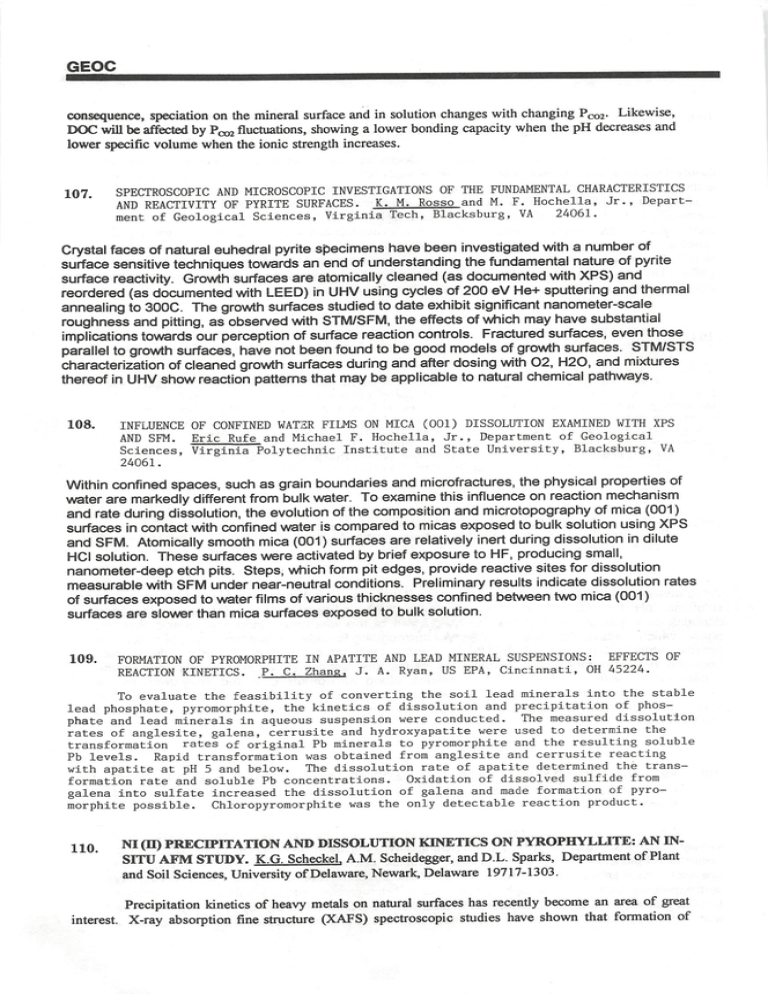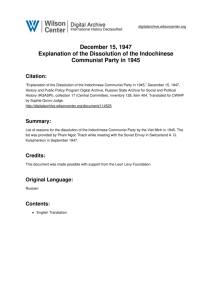consequence, speciation on the mineral surface and in solution changes... DOC will be affected by Pco2 fluctuations, showing a lower...
advertisement

GEOC
consequence, speciation on the mineral surface and in solution changes with changing Pcoa- Likewise,
DOC will be affected by Pco2 fluctuations, showing a lower bonding capacity when the pH decreases and
lower specific volume when the ionic strength increases.
107. SPECTROSCOPIC AND MICROSCOPIC INVESTIGATIONS OF THE FUNDAMENTAL CHARACTERISTICS
AND REACTIVITY OF PYRITE SURFACES. K. M. Rosso and M. F. Hochella, Jr., Depart
ment of Geological Sciences, Virginia Tech, Blacksburg, VA 24061.
Crystal faces of natural euhedral pyrite specimens have been Investigated with a number of
surface sensitive techniques towards an end of understanding the fundamental nature of pyrite
surface reactivity. Growth surfaces are atomically cleaned (as documented with XPS) and
reordered (as documented vwth LEED) in UHV using cycles of 200 eV He+ sputtering and thermal
annealing to 300C. The growrth surfaces studied to date exhibit significant nanometer-scale
roughness and pitting, as observed with STM/SFM, the effects of which may have substantial
implications towards our perception of surface reaction controls. Fractured surfaces, even those
parallel to growth surfaces, have not been found to be good models of growth surfaces. STM/STS
characterization of cleaned grovrth surfaces during and after dosing with 02, H20, and mixtures
thereof in UHV show reaction patterns that may be applicable to natural chemical pathways.
108. INFLUENCE OF CONFINED WATER FILMS ON MICA (001) DISSOLUTION EXAMINED WITH XPS
A N D S F M . E r i c R u f e a n d M i c h a e l F. H o c h e l l a , J r . , D e p a r t m e n t o f G e o l o g i c a l
Sciences, Virginia Polytechnic Institute and State University, Blacksburg, VA
24061.
Within confined spaces, such as grain boundaries and microfractures, the physical properties of
water are markedly different from bulk v^rater. To examine this influence on reaction mechanism
and rate during dissolution, the evolution of the composition and microtopography of mica (001)
surfaces in contact vwth confined water is compared to micas exposed to bulk solution using XPS
and SFM. Atomically smooth mica (001) surfaces are relatively inert during dissolution in dilute
HCI solution. These surfaces were activated by brief exposure to HF, producing small,
nanometer-deep etch pits. Steps, which form pit edges, provide reactive sites for dissolution
measurable with SFM under near-neutral conditions. Preliminary results indicate dissolution rates
of surfaces exposed to water films of various thicknesses confined between two mica (001)
surfaces are slower than mica surfaces exposed to bulk solution.
109. FORMATION OF PYROMORPHITE IN APATITE AND LEAD MINERAL SUSPENSIONS: EFFECTS OF
REACTION KINETICS. P. C. Zhang. J. A. Ryan, US EPA, Cincinnati, OH 45224.
To evaluate the feasibility of converting the soil lead minerals into the stable
lead phosphate, pyromorphite, the kinetics of dissolution and precipitation of phos
phate and lead minerals in aqueous suspension were conducted. The measured dissolution
rates of anglesite, galena, cerrusite and hydroxyapatite were used to determine the
transformation rates of original Pb minerals to pyromorphite and the resulting soluble
Pb levels. Rapid transformation was obtained from anglesite and cerrusite reacting
with apatite at pH 5 and below. The dissolution rate of apatite determined the trans
formation rate and soluble Pb concentrations. Oxidation of dissolved sulfide from
galena into sulfate increased the dissolution of galena and made formation of pyro
morphite possible. Chloropyromorphite was the only detectable reaction product.
110 NI (n) PRECIPITATION AND DISSOLUTION KINETICS ON PYROPHYLLITE: AN INsnu ATM STUDY. K.G. Scheckel. A.M. Scheidegger, and D.L. Sparks, Department of Plant
and Soil Sciences, University of Delaware, Newark, Delaware 19717-1303.
Precipitation kinetics of heavy metals on natural surfaces has recently become an area of great
interest. X-ray absorption fine structure (XAFS) spectroscopic studies have shown that formation of
GEOC
mixed Ni/Al complexes can occur within a matter of minutes even with surface loadings less than
monolayer coverage. In this study, in-situ atomic force microscopy (AFM) and batch techniques were
employed to examine precipitation of Ni on pyrophyllite, an ideal 2:1 clay mineral, over a 24 hour period.
More important is the dissolution of the metal from the surface precipitate and the overall alteration of the
mineral surface. However, research in this area has been very limited. To accurately predict the fate of
metals in the environment, comprehension about rates and mechanisms regarding dissolution kinetics of
surface precipitates is imperative. Using a Fluid Cell, AFM was applied to follow in-situ dissolution of
the surface precipitates and the results were compared with batch dissolution studies.
111.
REDUCTIVE DISSOLUTION OF IRON OXIDES BY CYSTEINE A. Amirbahman , U. von Gunten, and L.
Sigg, Swiss Federal Institute of Environmental Science and Technology (EAWAG), CH-8600 Diibendorf,
Switzerland.
Cysteine, an amino acid and a building block for some proteins, is used as a model compound to develop
further insight into the bacterially-mediated iron reduction. Dissolution experiments for the amorphous
ferrihydrite (HFO) were conducted as a function of the total cysteine concentration and at different pH
values. Equilibrium modeling of the pH adsorption edge, and the pH-dependent dissolution behavior
indicate the presence of a protonated and a deprotonated cysteine surface species. While the former is the
dominant surface species at most pH values, electron transfer takes place mainly through the latter surface
species. Experiments with other iron oxide phases show the following order for the reductive dissolution
rates: HFO > lepidocrocite > goethite.
112. SOLUBILITY OF Fe(III) IN SEAWATER. F, J. Millero, Rosenstiel School of Marine and Atmospheric Science,
University of Miami, Miami, Florida 33149-1098
The recent solubility measurements of Kuma et al. (1996) in seawater (pH = 5 to 8) have been examined using a
speciation model for Fe(III). The results indicate that the effect of pH (2 to 9) on UV irradiated coastal waters and the
earlier filtration measurement of Byrne and Kester (1976) can be adequately represented by considering the formation of
FeOH^' and Fe(OH)i* using the hydrolysis constants for (K*, = 10'^", K*2 = 10 '°) determined by Millero et al. (1995). The
solubility measurements in coastal waters without UV irradiation require the consideration of formation of Fe(0H)3 (K*j =
1013 J) measurements on open ocean waters also require the formation of Fe(OH)3 (K*3 = 10"'") and a different value
for the hydrolysis constant for the formation Fe(OH)2* (K*2 = lO""). The need for a value of K'j for the formation of
Fe(0H)3 in coastal and ocean waters may be related to the formation of complexes with organic ligands or the stabilization
of the colloidal Fe(OH)3. The model calculations for the solubility of Fe{III) at pH = 8.1 (0.3 nM) are in good agreement
with measured open ocean surface waters (0.2 nM) and deep waters (0.6 nM) determined by various workers. The effect of
organic material on the solubilities of Fe(IlI) in coastal and open ocean waters is found to be between 30 to 60% at a pH =
8.1. This is in reasonable agreement with the fraction of Fe(in) complexed with organic material determined by
polarographic techniques (12 to 97%). Since these calculations are strongly dependent upon the relative levels of total Fe
and organic ligands in the waters, future studies should include solubility and polarographic measurements on the same
sample to clarify these relationships.
11 3 .
IONIC STRENGTH AND MEDIUM COMPOSITION DEPENDENCE OF FERRIC
COMPLEXATION BY CHLORIDE AND SULFATE IONS. W. Yao and R.H. Byrne, Department of
Marine Science, University of South Florida, St. Petersburg, Florida 33701
Despite the widely acknowledged importance of iron In geological, biological and environmental
contexts, important fundamental aspects of iron solution chemistry remain poorly understood. In
this study, spectrophotometric measurements of Fe(lll) complexation by chloride and sulfate ions
have been made at 25 oC and various ionic strengths in the range of 0.1 - 6.0 M. Complexation
results are described using Pitzer's specific interaction equations. Pitzer parameters for Fe(lll) ion
and ion pairs (FeCI and FeS04) have been determined, and the influence of calcium and
magnesium ions on Fe{lll) formation constants is described.




